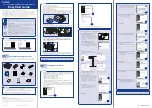
Banner AG4 Series Safety Laser Scanner
and the MPCEs are located in different enclosures. For this reason, dual-channel control with EDM monitoring should be
used in any installation where the FSDs are located remotely from the MPCEs.
Single-Channel Control
Single-channel control uses a series connection of FSD contacts to form a safe switching point. After this point in the
machine’s safety-related control system, failures can occur that would result in the loss of the safety function (such as a
short-circuit to a secondary source of energy or voltage).
For this reason, single-channel control interfacing should be used only in installations where FSD safety stop circuits
and the MPCEs are mounted within the same control panel, adjacent to each other, and are directly connected to each
other; or where the possibility of such a failure can be excluded. If this cannot be achieved, then dual-channel control
should be used.
Methods to exclude the possibility of these failures include, but are not limited to:
Physically separating interconnecting control wires from each other and from secondary sources of power.
Routing interconnecting control wires in separate conduit, runs, or channels.
Locating all elements (modules, switches, and devices under control) within one control panel, adjacent to
each other, and directly connected with short wires.
Properly installing multi-conductor cabling and multiple wires through strain relief fittings. (Over-tightening of a
strain-relief can cause short-circuits at that point.)
Using positive-opening or direct-drive components, installed and mounted in a positive mode.
3.7.3 Machine Primary Control Elements and External Device Monitoring
A machine primary control element (MPCE) is an ―electrically powered element that directly controls the normal
operation of a machine in such a way that it is the last element (in time) to function when machine operation is to be
initiated or arrested
‖ (
per IEC61496-1). Examples include motor contactors, clutch/brakes, valves, and solenoids.
Depending on the level of risk of harm, it may be required to provide redundant MPCEs or other control devices that are
capable of immediately stopping the dangerous machine motion, irrespective of the state of the other. These two
machine control channels need not be identical (they could also be diverse redundant), but the stop time performance
of the machine (Ts, used to calculate the safety distance, see Sections 3.3.4 and 3.3.5) must take into account the
slower of the two channels. Refer to Figure 3-20 or consult the machine manufacturer for additional information.
To ensure that an accumulation of failures does not compromise the redundant control scheme (i.e., cause a failure to
danger) a method to verify the normal functioning of MPCEs or other control devices is required.
The Scanner provides
this function only when configured for manual start/restart (reset) with MPCE monitoring contacts wired in
series with the reset (start/restart) switch
as shown in Figure 3-19 (see also 3.3.7 Reset Switch Location).
When the Scanner is configured for Automatic Start/Restart (Reset), to properly monitor the MPCEs an
External Device Monitoring (EDM) function must be provided by an external means from the Scanner.
One
example using the
UM-FA-9A/-11A
safety Module is shown in Figure 3-20.
The
UM-FA-9A/-11A
can be configured for
both manual or automatic reset and provide the required EDM function.
For external device monitoring to function properly, each device must include a normally closed (N.C.), forced-guided
(mechanically linked) contact that can accurately reflect the status of the device. This ensures that the normally open
contacts, used for controlling hazardous motion, have a positive relationship with the normally closed monitoring
contacts and can detect a failure to danger (e.g., contacts that welded closed or stuck ON).
It is strongly recommended that a normally closed, forced-guided monitoring contact of each FSD and MPCE be
connected to EDM inputs (see Figures 3-19 and 3-20). If this is done, proper operation will be verified. Monitoring FSD
and MPCE contacts is one method of maintaining control reliability (OSHA/ANSI) and Category 3 and 4 (ISO13849-1).
If monitoring contacts are not available or do not meet the design requirement of being forced-guided (mechanically
linked), it is recommended to:
Replace the devices so that they are capable of being monitored, or
Incorporate the EDM function into the circuit as close to the MPCE as possible (e.g., monitor the FSDs), and
Employ use of well-tried, tested, and robust components, and generally accepted safety principles, including
fault exclusion, into the design and installation to either eliminate, or reduce to an acceptable (minimal) level of
risk, the possibility of undetected faults or failures that can result in the loss of the safety function.
Buy: www.ValinOnline.com | Phone 844-385-3099 | Email: CustomerService@valin.com
















































